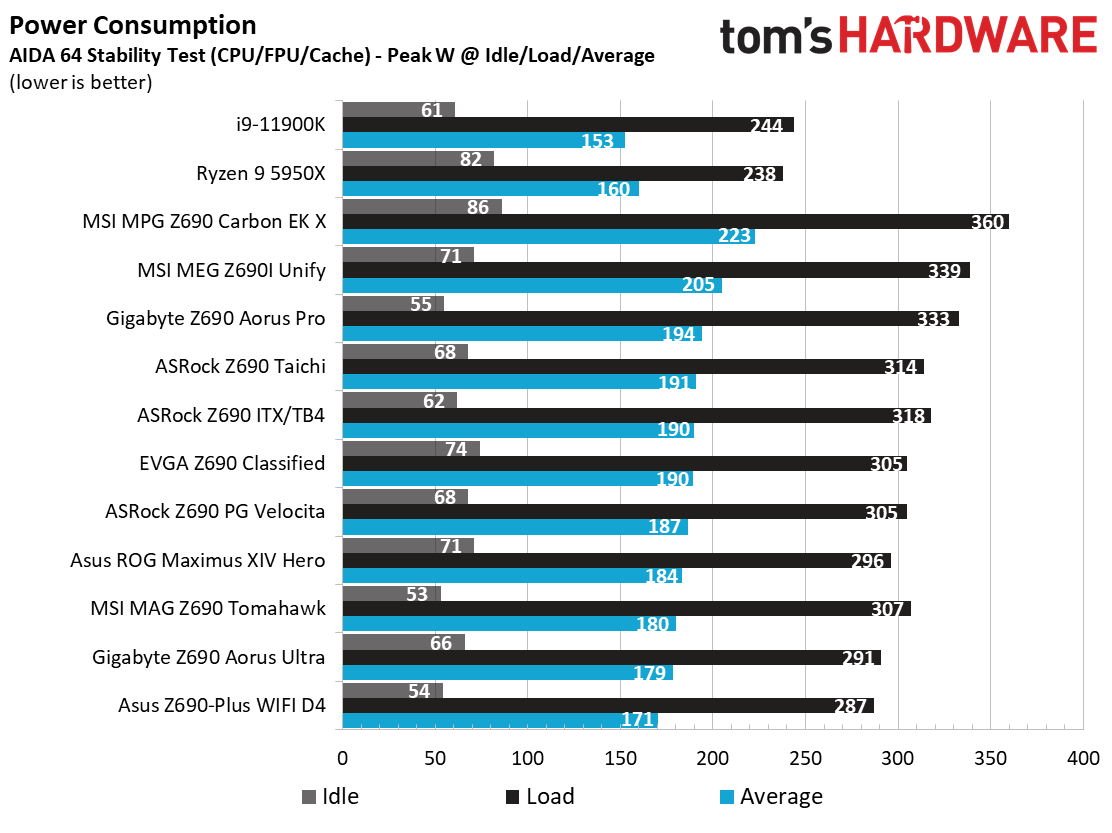Why you can trust Tom's Hardware
Our standard benchmarks and power tests are performed using the CPU’s stock frequencies (including any default boost/turbo), with all power-saving features enabled. We set optimized defaults in the BIOS and the memory by enabling the XMP profile. For this baseline testing, the Windows power scheme is set to balanced (default), so the PC idles appropriately.
To get the most out of the Intel Alder Lake chips, you need to be on Windows 11 with its updated scheduler. In most cases, Windows 10 performs well. However, some tests (Cinebench R20, Corona and POVRay) take a significant hit. In short, if you’re going with Alder Lake, you must upgrade to Windows 11 for the best results across the board. That may change with patching and updates in the future, though.
Synthetic Benchmarks
Synthetics provide a great way to determine how a board runs, as identical settings should produce similar performance results. Turbo boost wattage and advanced memory timings are places where motherboard makers can still optimize for either stability or performance, though, and those settings can impact some testing.





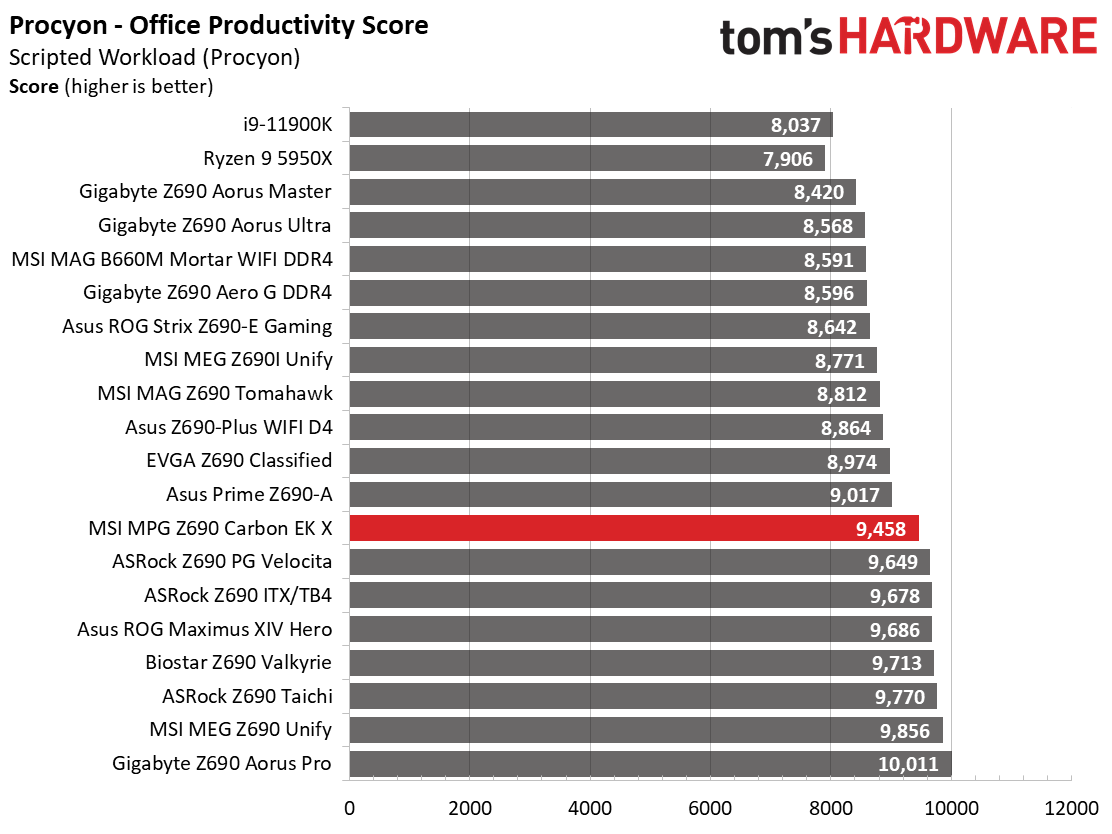



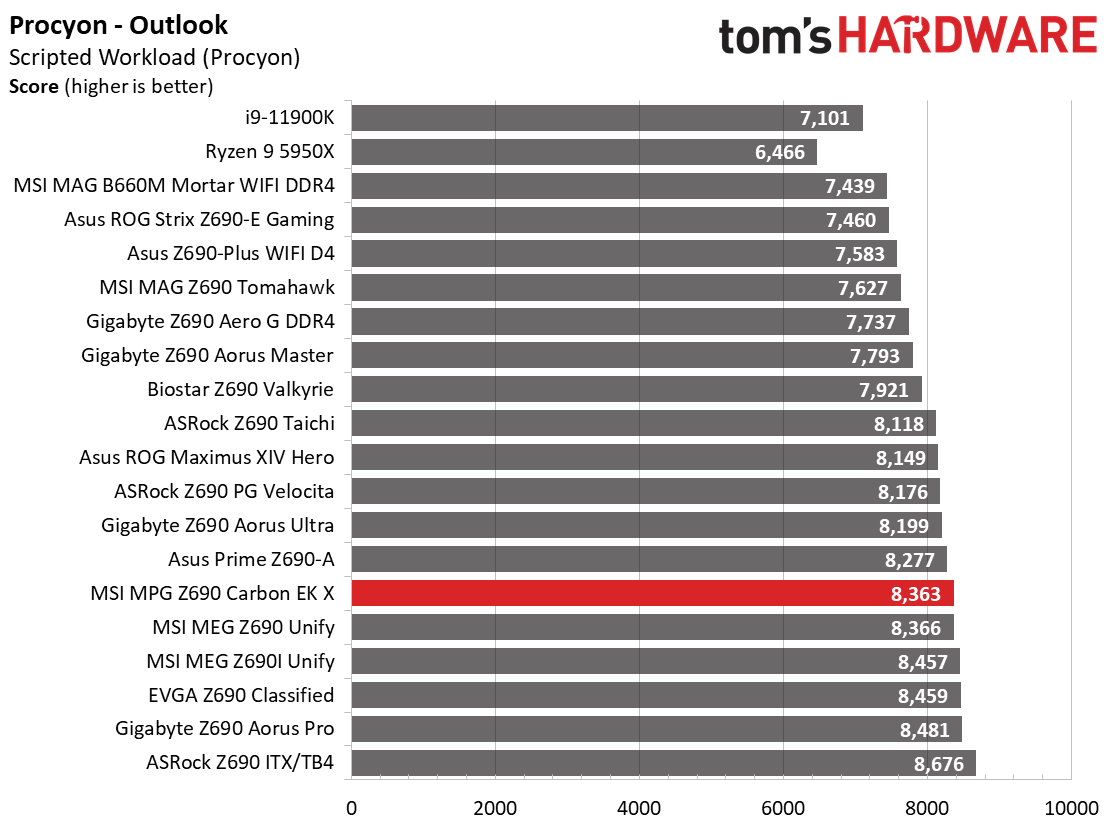
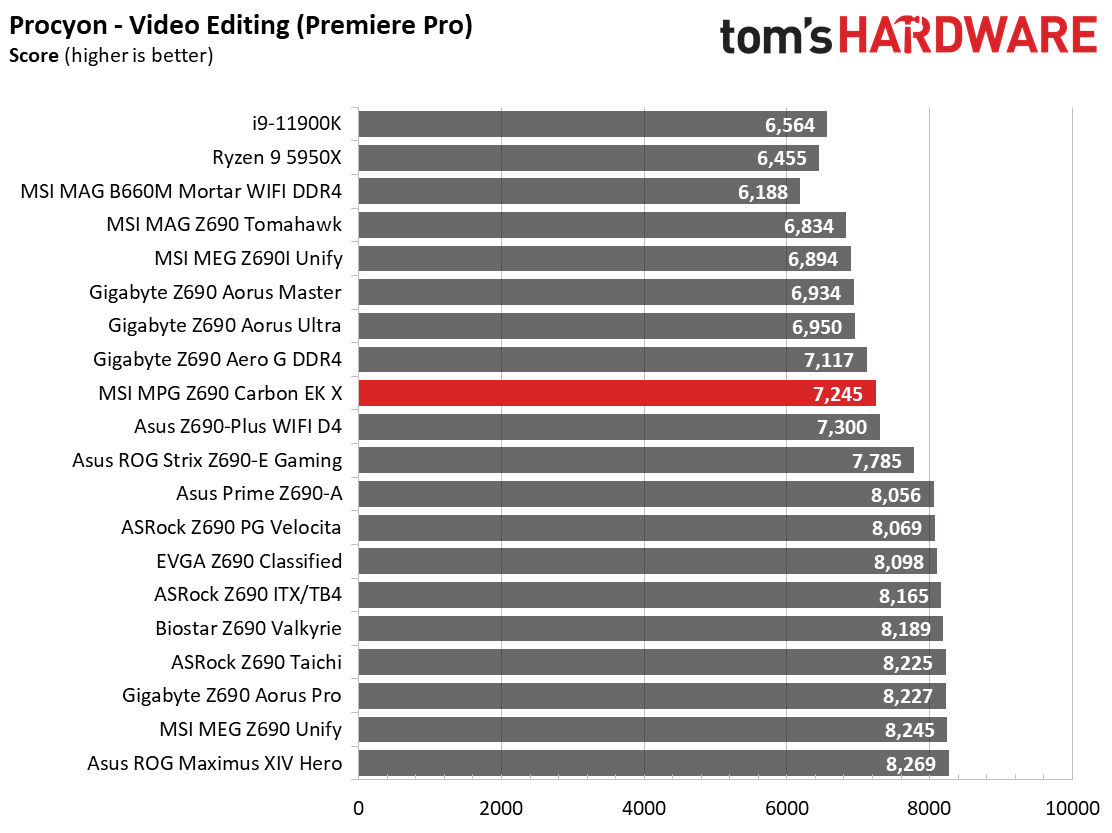




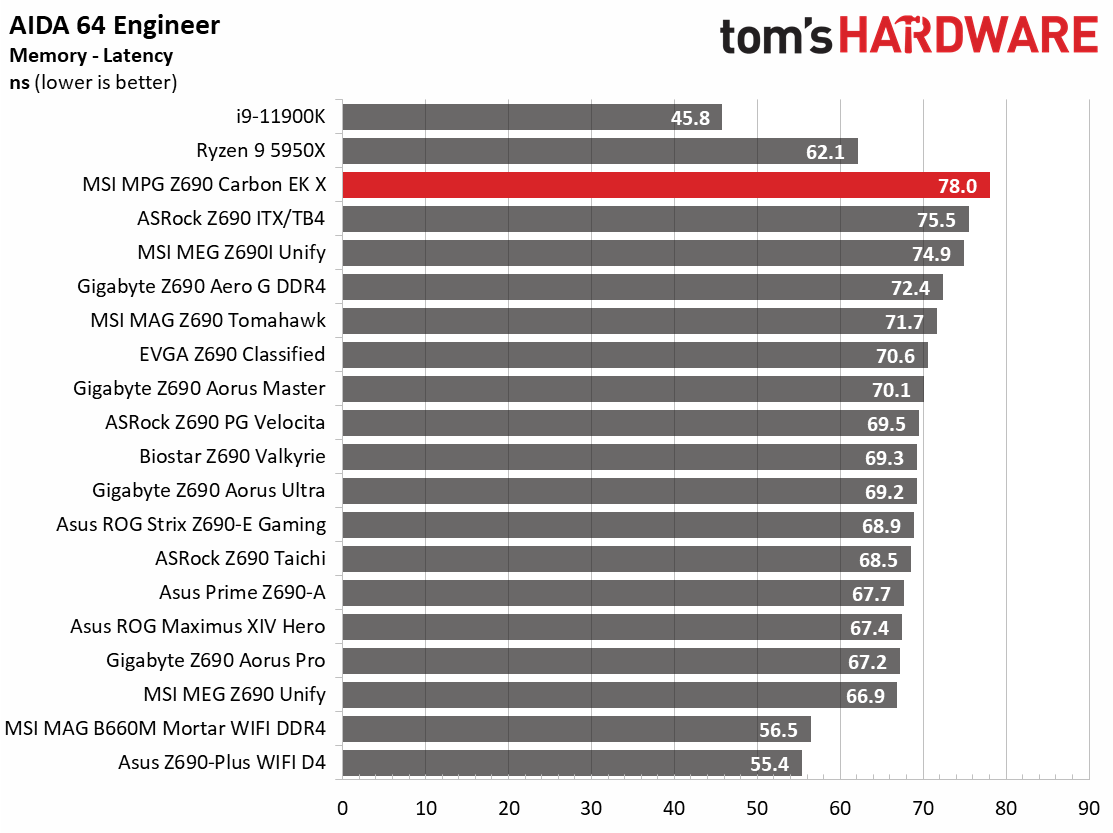
The Z690 Carbon EK X was around average in our synthetic benchmarks. It did well overall in the Procyon Office tests, but was slightly below average in Photo and Video editing. 7Zip and Cinebench R23 also ran on the slower side of average.
Timed Applications




The Carbon EK X showed good results in LAME (9.53 seconds, tied for second fastest) test, and the Corona ray tracing test was average at 53 seconds. Handbrake results were also solid, with the x264 test one of the fastest so far, while the x265 performance was average in a tight group of results.
3D Games and 3DMark




Starting with the launch of the Z690 chipset, we’ve updated our game tests, updating to Far Cry 6 and shifting from F1 2020 to F1 2021. We run the games at 1920x1080 resolution using the Ultra preset (details listed above). As the resolution goes up, the CPU tends to have less impact. The goal with these settings is to determine if there are differences in performance at the most commonly used resolution with settings most people use or at least strive for. We expect the difference between boards in these tests to be minor, with most falling within the margin of error differences. We’ve also added a minimum FPS value, as that can affect your gameplay and immersion experience.
In F1 2021, the Z690 Carbon EK X averaged 164 frames per second (fps) with minimums of 140 fps, an average result. In Far Cry 6, the EK X averaged 137 fps with a minimum of 122 fps, some of the better results thus far.
Get Tom's Hardware's best news and in-depth reviews, straight to your inbox.
Our trend of not seeing significant differences among Z690 boards continues in our synthetic benchmarks. The MSI scored 14,260 on 3DMark Time Spy and 16,931 on Fire Strike Extreme. The former is on the lower side of average, but nothing noticeable outside of this benchmark.
Power Consumption / VRM Temperatures
We used AIDA64’s System Stability Test with Stress CPU, FPU and Cache enabled for power testing, using the peak power consumption value. The wattage reading is from the wall via a Kill-A-Watt meter to capture the entire PC minus the monitor. The only variable that changes is the motherboard; all other parts are the same.
At idle, the Carbon EK X on the test bench consumed 86W, the highest idle result so far, along with the load wattage that was also the highest recorded at 360W. The high power use is due to the addition of an external pump and more powerful fans than our AIO cooler uses. Left to default, the board ramps up to the same 4.9/3.7 GHz clock speeds we’re used to seeing. It could get away with using less voltage, however.




During stock stress testing, we saw thermal throttling due to the board’s liberal use of voltage by default. Because of this and some poor VRM contact on this sample, temperatures were higher than I would like to see. The room temperature was a couple of degrees Celsius higher than normal as my Window AC unit is down, and it was an unusually warm day outside, so that played a part in the results as we do not normalize to a specific temperature. Overclocked results where the voltage was locked to ~1.25V did well and ran cooler than those using air only. The monoblock keeps the CPU, VRM and M.2 socket cool, but make sure you get check contact with the block. It took me two attempts to get enough paste down. Otherwise, installing the monoblock was straightforward, though the included instructions were lacking in detail.
Overclocking
Overclocking with Alder Lake is slightly different from what we’re used to due to the hybrid core configuration. Now, you can overclock the P and E cores separately, though they both use the same voltage domain. You can push one and not the other, or both, so there’s some flexibility. To that end, we set an overclock to 5.1 GHz across all P-cores and 4.1Ghz on all E-cores. This yields a 200 MHz bump on the P-cores and a 400 MHz increase on the E-cores. We’re topped out on the P-cores, primarily due to temperatures, but the more efficient E-cores still have some headroom.
Overclocking with the Carbon EK X and the flagship 8+8-core/24-thread i9-12900K proved painless. Since we’ve found our required voltage with our first review, we plugged in that 1.25V value for Vcore, adjusted LLC to LLC4, and tested it successfully. According to CPUz, the voltage was 1.235V, so using LLC4 effectively mitigated the vdroop.
On the memory front, we set XMP and off we went with our GSkill Trident Z5 DDR5 5600 CL36 kit and the faster ADATA XPG DDR5 6000 kit. This yields an 800 and 1,200 MHz (respectively) increase from the maximum stock rating of the platform (DDR5 4800). We’re sure there’s more overclocking headroom available, but as always, your mileage may vary depending on the kit and quality of your CPUs integrated memory controller (IMC).
Bottom Line
After building and testing, I’m left with a good feeling for the Z690 Carbon EK X. While some other boards include water blocks on the board, most are in a different class altogether. Anything with a block from Asus, Gigabyte, or ASRock are built around flagship-class boards and cost at least $1,300. At $629.99, the Carbon EK X comes mostly with features you’d expect from a mid-range class board, including five M.2 sockets, 10 USB ports on the rear IO, plus the included EK monoblock to cool the CPU VRMs and top M.2 socket. If you intend to water cool the critical parts of your motherboard, MSI’s Z690 Carbon EK X is, by far, the least-expensive option with a custom monoblock included.
For the most part, the board itself has an impressive specifications list. Although it doesn’t have a PCIe 5.0 M.2 socket, it does come with five PCIe 4.0 sockets, which is the most you’ll see integrated on any Z690-based motherboard. There are also six total SATA ports, making this quite a board on the storage front. It also comes with flagship-class audio, Intel-based networking, an updated appearance, and improved power delivery. Overall it’s a well-rounded Z690 motherboard. If you like what you see, but don’t plan on spending the time or money on a custom loop, the Z690 Carbon, its air-cooled twin, is available for a lot less ($399.99).
There isn’t anything else close to the EK X’s price point as far as direct competition goes. The more expensive options we listed above are flagship-class which tend to have more, or higher-end, features or both. The big takeaway from the Z690 Carbon EK X is the ability to water cool the critical bits and get the matching custom monoblock in one package. You’ll still need to buy the rest of the loop, but at least the problem of finding a block is already done for you, and it includes EK’s handy leak tester. If you’re looking to build an Alder Lake-based system and plan to water cool the motherboard and the CPU, MSI’s MPG Z690 Carbon EK X is feature-laden and the least expensive option with a custom-made block.
MORE: Best Motherboards
MORE: How To Choose A Motherboard
MORE: All Motherboard Content
Current page: Benchmark Results and Final Analysis
Prev Page Firmware, Software and Test System
Joe Shields is a staff writer at Tom’s Hardware. He reviews motherboards and PC components.
